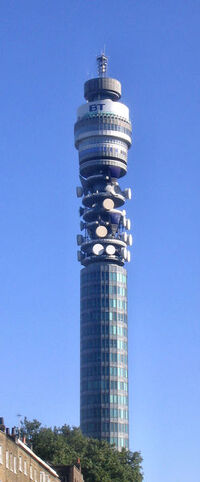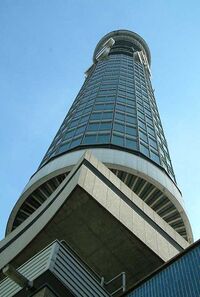
BT Tower from the Euston Road, looking south.

Annotated 1995 view from BT Tower webcam on T35

The tower seen from its base
The BT Tower is a tall cylindrical building in London, England. The tower is located at 60 Cleveland Street, Fitzrovia. It has been previously known as the Post Office Tower and the British Telecom Tower. The main structure is 177m tall, with a further section of aerial bringing the total height to 189m. Contrary to popular belief, it is not the same as the BT Centre (the national headquarters of BT).
History
The tower was commissioned by the General Post Office (GPO). Its primary purpose was to support the microwave aerials then used to carry telecommunications traffic from London to the rest of the country.
It replaced a much shorter steel lattice tower which had been built on the roof of the neighbouring Museum telephone exchange in the late 1940s to provide a television link between London and Birmingham. The taller structure was required to protect the radio links' "line of sight" against some of the tall buildings in London then in the planning stage. These links were routed via other GPO microwave stations at Harrow Weald, Bagshot, Kelvedon Hatch and Fairseat, and to places like the London Air Traffic Control Centre at West Drayton.
The tower was designed by the architects of the Ministry of Public Building and Works: the chief architects were Eric Bedford and G. R. Yeats]. Typical for its time, the building is concrete clad in glass. The narrow cylindrical shape was chosen because of the requirements of the communications aerials: the building will shift no more than 25cm in wind speeds of up to 150 km/h (95 mph). Initially the first sixteen floors were for technical equipment and power, above that was a 35 metre section for the microwave aerials, and above that were six floors of suites, kitchens, technical equipment and finally a cantilevered steel lattice tower. To prevent heat build-up the glass cladding was of a special tint. The construction cost was £2.5 million.
Construction began in June 1961. The tower was topped out on 15 July 1964 and officially opened by Prime Minister Harold Wilson on 8 October 1965. The building contractors were Peter Lind & Company.
The tower was originally designed to be just 111m, and its foundations are sunk down through 53 metres of London clay and are formed of a concrete raft 27 metres square, a metre thick, reinforced with six layers of cables on top of which sits a reinforced concrete pyramid.
The tower was officially opened to the public on 16 May 1966 by Tony Benn and Billy Butlin. As well as the communications equipment and office space there were viewing galleries, a souvenir shop, and a rotating restaurant, the "Top of the Tower", on the 34th floor, operated by Butlins. It made one revolution every 22 minutes. The first race up the stairs of the tower was in 1968 and was won by Edinburgh University medical student Jack Macfie.
A bomb, responsibility for which was claimed by the Provisional IRA, exploded in the roof of the men's toilets at the Top of the Tower restaurant on 31 October 1971. The restaurant was closed to the public for security reasons in 1980, the year in which the Butlins' lease eventually expired. Public access to the building ceased in 1981. The Tower is sometimes used for BT Corporate events, but is not available for hire or use by outside companies. The closure of the Tower restaurant to the public means London has no revolving restaurant of the type common in major cities throughout the world.
The BT Tower today
When the GPO telecommunications services were split off in 1981 (in advance of the 1984 privatisation) the tower was renamed the British Telecom Tower. After the rebranding of the company in 1992 it became the BT Tower. The building is no longer open to the public. The restaurant has been re-opened as a venue for use by BT for events and promotions: since the re-discovery of spare parts for the mechanism, it is even rotated occasionally. Occasional broadcasts are made from the top of the tower, including BBC Radio 1 DJ Chris Moyles on his birthday, 22 February 2006.
The tower is still in use, and is the site of a major UK communications hub.
Microwave links have been replaced by Subterranean fibre optic links for most mainstream purposes, but the former is still in use at the tower. The second floor of the base of the tower contains the TV Network Switching Centre which carries broadcasting traffic and relays signals between television broadcasters (including the BBC), production companies, advertisers, international satellite services and uplink companies.
The outside broadcast control is located about the former revolving restaurant, with the kitchens on floor 35.
A renovation in the 2000s installed coloured lighting projecting onto a new 360-degree light panel, extending out from the old light boxes, bearing the company logo, as part of BT's "connected world" corporate styling. Seven colours are programmed to vary constantly at night and are intended to appear as a rotating globe. The success of this is debatable but the building's night appearance is now more distinctive. The tower has always been a useful late-night navigational beacon for nearby residents, especially the numerous university halls within walking distance.
Until the mid-1990s, the building was officially a secret, and did not appear on official maps. Its existence was finally "confirmed" by Kate Hoey, MP, on 19 February 1993: "Hon. Members have given examples of seemingly trivial information that remains officially secret. An example that has not been mentioned, but which is so trivial that it is worth mentioning, is the absence of the British Telecom tower from Ordnance Survey maps. I hope that I am covered by parliamentary privilege when I reveal that the British Telecom tower does exist and that its address is 60 Cleveland Street, London."
The BT Tower was given Grade II listed building] status in 2003, several of the now defunct antennas located on the building now cannot be removed, as they are protected by this listing.
Entry to the building is provided by two high-speed lifts which travel at 6 metres per second, reaching the top of the building in 30 seconds. Interestingly, an Act of Parliament was passed to vary fire regulations, allowing the building to be evacuated by using the lifts — it is the only building in the country where this is permitted.
BT Tower in London is being used in a major study to help improve the air quality in the capital - with the aim of reducing serious effects on human health.
Appearances in fiction
- Large portions of the 1966 Doctor Who serial The War Machines were set in the tower.
- In the 1967 film Smashing Time it appeared to spin out of control and short-circuit the whole of London's power supply.
- The tower is featured in Stanley Donen's 1967 film Bedazzled as a vantage point from which Peter Cook, playing Satan, launches various forms of mischief.
- The tower is featured in the most famous scene in The Goodies when it is toppled over by Twinkle the Giant Kitten in the episode Kitten Kong.
- In Alan Moore's graphic novel V for Vendetta the tower is headquarters for both the "Eye", and the "Ear", the visual and audio surveillance divisions of the government. The tower is destroyed through sabotage. It's also featured in the film adaptation although it is not destroyed. It is renamed BTN Tower in the film.
- The tower is destroyed in the James Herbert novel The Fog by a Boeing 747 whose captain has been driven mad by fog.
- The tower appears abandoned and covered in pleurococcus in a BBC TV adaption of The Day of the Triffids.
- The design of the starship HMS Camden Lock from the BBC 2 science fiction sitcom Hyperdrive is based on the tower.
- In Harry Potter and the Chamber of Secrets, Harry is spotted flying over the tower in a Ford Anglia] with his friend, Ron Weasley.
- It appears on the cover of, and figures in, Saturday by Ian McEwan.
- Frank Muir's short story "The law is not concerned with trifles" is set in the tower's revolving restaurant.
- Rowan Atkinson in Not the Nine O'Clock News plays a Frenchman who claims that the Post Office Tower was not a communications tower but a London phallus.
- In The Bourne Ultimatum movie, there is a helicopter's view shot of the tower building for a brief period of time to show the location.
- In Season 4 of ReBoot, a tower closely resembling the BT tower is seen in the first episode as a control tower being able to open the system of Mainframe to the net.
- In Patrick Keiller's film London (1992) the narrator claims the tower is a monument to the love affair between Arthur Rimbaud and Paul Verlaine, who lived nearby.
- The bombing is a central plot feature of Hari Kunzru's 2007 novel My Revolutions, in which the bomb is the work of political radicals who are never caught.
| This page uses Creative Commons Licensed content from Wikipedia (view authors). That Wikipedia page probably contains more information. |